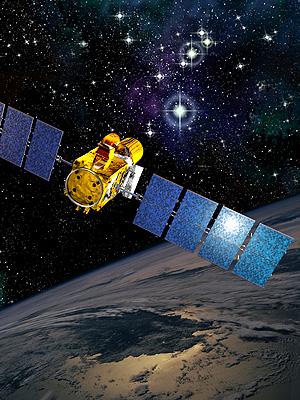Among other things, the space telescope discovered pulsations of sound waves passing through distant stars as well as at least one planet
 The Corot space telescope of the European Space Agency COROT (Convection, Rotation and Planetary Transits), recently completed its first year of activity in orbit around the Earth. The observatory yielded surprises after 300 days of scientific observations.
The Corot space telescope of the European Space Agency COROT (Convection, Rotation and Planetary Transits), recently completed its first year of activity in orbit around the Earth. The observatory yielded surprises after 300 days of scientific observations.
The satellite observes a large number of stars, up to 12 thousand at the same time, using sophisticated instruments and with a precision that cannot be obtained from ground observatories. The key to the high accuracy of the observation is that, for the first time, the satellite can be aimed for long periods in the same direction - up to 159 days.
The satellite measures the change in the light output of these stars down to the level of one part in a million. This level of precision allows scientists to study the many ways stars change. The pulsations can be caused either by an unknown physical process within the star or by an object such as a planet passing in front of the star.
Seismology of stars
So far, the satellite has observed 30 stars as part of a secondary study dealing with stellar seismology - the study of tiny changes in the light output from the star caused by acoustic waves passing through the star. The pattern of their change tells us a lot about what is happening inside the star. The stars mapped by Corot span a wide range from stars similar to our Sun to older and more massive stars. The observation periods ranged from 20 to 150 days of uninterrupted study. After an initial analysis of the data it turns out that there were interesting results to be observed.
Studying the fluctuations of stars similar to the Sun is an important goal in the operation of the satellite. These fluctuations have already been found in two stars very similar to our Sun - first HD49933 and then HD181420. The intensity of the variation is very weak and given the short consistency time (the length of time a specific sound wave crosses the surface of the star), it is very difficult to detect and measure them.
Discovery of a second planet
On May 4, 2007 we reported that COROT scientists had discovered a planet At such an early stage of the telescope's operation, which was above and beyond the expectations they had before the launch. The new planet is called Corot-exo-1b and it lies 1,500 light-years away in the direction of the Unicorn group, a discovery in which researchers at Tel Aviv University's Mitzpe Ramon Observatory were partners. Now the scientists report on the second planet COROT-exo-2b.
When a planet crosses in front of its sun, there is a dimming of the light output from the star, which can be detected using a Corot. Because many processes can cause the light signature to behave this way, to confirm the truth of the planet's existence, a large verification program is underway, which also includes assistance from ground-based telescopes. Although Corot observed thousands of light curves, the rate of discovery is dictated by the capacity of ground-based telescopes.
For example, in the third sequence of Corot observations, the planet COROT-exo-2b was discovered from in front of its star through real-time light curve analysis for the purpose of confirming the discovery. Additional observations were made simultaneously at the Metze Lahuite Provence in France and at the Southern European Observatory in Cielce, and confirmed the existence of the planet and even calculated its mass.
COROT-exo-2b orbits a Sun similar to our Sun, but slightly more massive, colder and more active. The system lies 800 light-years from Earth in the direction of the Serpent constellation. COROT-exo-2b is a gas giant, 1.4 times larger and 3.5 times more massive than Jupiter. Its average density is 1.5 grams per cubic meter, a little more than that of Jupiter. This massive planet orbits its Sun in less than two days from a distance of about 6 times the star's (Sun's) radius.
For the comprehensive news on the European Space Agency website
Previous news on the subject on the knowledge site
The COROT space telescope discovered a new planet
COROT launch - the beginning of a period in the detection of planets outside the solar system

2 תגובות
Large planets (Jupiter-like) start appearing all the time, and in this example too it is very close to its star, so it was relatively easy to find it.
You hardly hear about planets up to 5 times the mass of Earth, and certainly not at a reasonable distance from their star.. which is a shame, because we have to wait 😉
Do not pronounce the T, that is, Kuro